Rhithrogena semicolorata Curt. - Olive Upright
Phylum: Arthropoda - Class: Insecta - Order: Ephemeroptera - Family: Heptagenidae
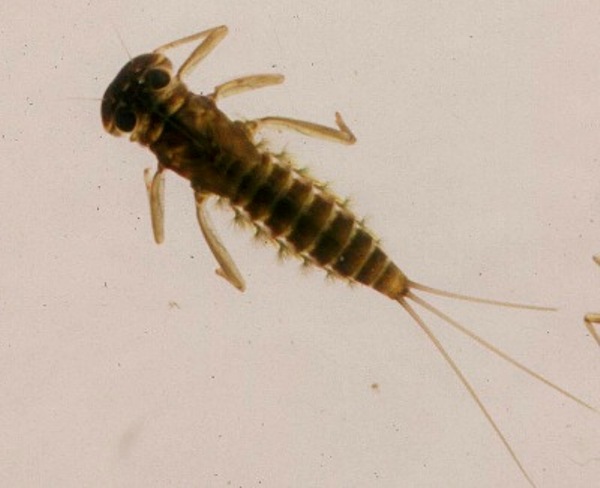
Immature nymph of the Olive Upright
This species was described scientifically in 1834 by English entomologist and illustrator John Curtis (1791 - 1862), who gave it the binomial name Rhithrogena semicolorata. Deprecated synonyms include Rhithrogena semitincta Pictet, Rhithrogena vulpecula Klapalek, and Rhithrogena grisoculata Bogoescu.
You may also see the scientific name of this genus written as Rithrogena rather than Rhithrogena, particularly in older books on angling entomology, but I have also seen Rithrogena used in scholarly research articles. The correct spelling is Rhithrogena.
The Olive Upright, a close relative of the March Brown, is found on just about every river in Britain, and it is probably the most abundant spring fly of all. The nymphs are flattened stone clingers with small gills each comprising a plate plus a tuft of fine filaments. Unlike the March Brown, the Olive Upright is found in all kinds of running water, including alkaline chalkstreams and acidic spate rivers.
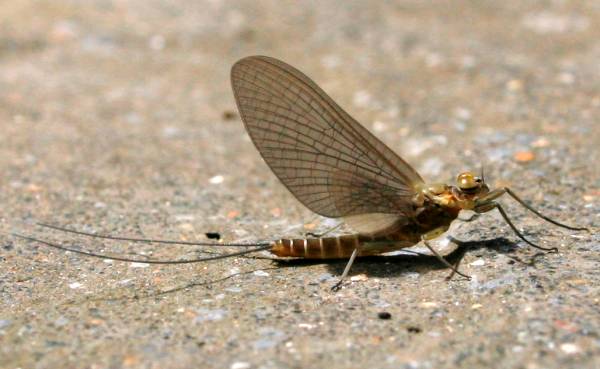
Male dun of the Olive Upright
Dun or subimago
The dun hatches throughout the day from May until August or early September. (June is usually the peak month.) Hatches are often heaviest towards evening, and at that time the spinners also appear. Their egg laying occurs very late in the day, so that the duns are usually far more important as far as trout fishers are concerned.
This is a particularly important river fly in spring, and it is also well worth imitating if you are fishing for wild brown trout at that time of the year. The hatches are less dense than those of the other common Rhithrogena species in Britain, the March Brown, Rhithrogena germanica, but in compensation you are likely to have a much longer fishing day with Olive Uprights on the water and, of course, they are abundant for two or three times as many days as is the case with the March Brown.
Having fished on more than 200 rivers in Britain and Ireland, I have yet to find one where Olive Uprights are not present.
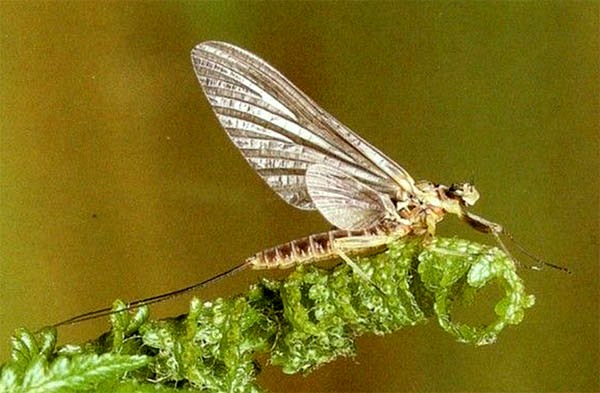
Female dun of the Olive Upright
Male and female duns are very similar in appearance. Although the nymphs have three tails, as adult flies the Olive Upright has just two tails.
Female Olive Uprights are slightly larger on average than the males, but as if to make up for it the males have much larger eyes than their mates. Body colouring is very similar in both sexes: greyish brown, but the male's body is more boldly ringed with orange bands. Depending on how the light catches them, the forewings of the duns are dark to mid blue-grey, while the largish hindwings are more buff than grey.
Because the duns trickle hatch over several hours each day, it is easy to underestimate how abundant these flies are, especially on northern and western rivers. (They are reported to be less in evidence on the very slow-flowing rivers of southeast England.)
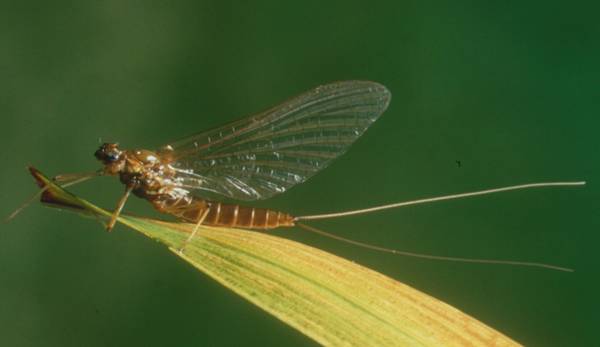
Female spinner of the Olive Upright
Spinner or imago
It is not until evening, when the male spinners begin swarming, that you are likely to become aware just how many of these flies hatch in a single day. I have seen swarms of several hundred male Olive Upright spinners dancing in the late afternoon sunlight beside a small stony stream. Once the cool of evening descends they seem to melt away; however, if you watch a swarm you will see plenty of females dropping in a selecting a mate. Paired, they then leave the swarm, and that is probably the last you will ever see of the male, although the female will eventually return to the river to deposit her eggs, either by sitting on a semi-submerged stone or by flying low over the water and dipping her ovipositor into the surface to release eggs periodically. Females fly slowly upstream, depositing eggs until their mission is competed; then they die either on the water or nearby. Needless to say, it is the dead females lying on the surface that trout find easiest to seize, and so rises to spent Olive Uprights are usually unhurried.
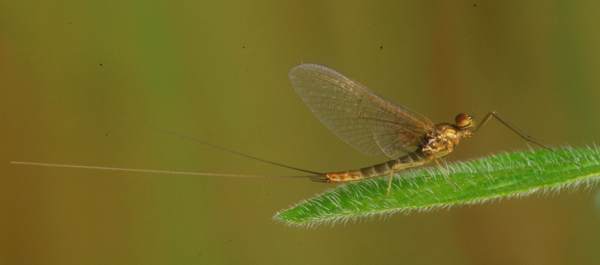
Male spinner of the Olive Upright
The body colour of Olive Upright spinners (males and females alike) is light to mid brown and the wings are brilliantly translucent, clear except for a bronze flush that is progressively darker near to the wing bases, and patterned with beautiful light-brown veining.
Wing veins
This is such a distinctive upwinged fly that there is no real need to study the wing veins closely in order to distinguish it from other members of the genus Rithrogena; however, if other identification features are not conclusive (and females in particular can be tricky) then it may be helful to check the wing veining.
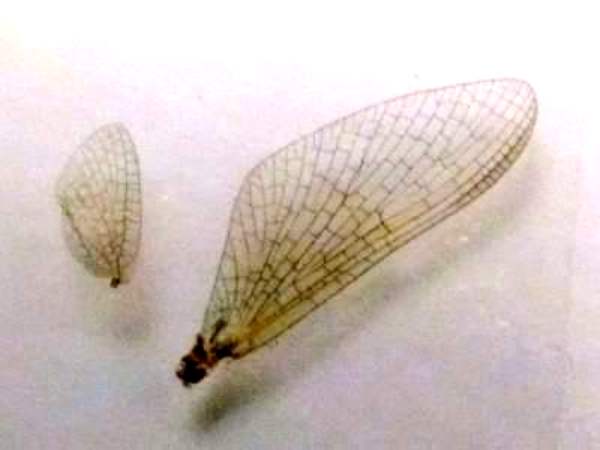
In the closeup picture shown here, both a forewing (the larger of the two wings) and a hindwing are shown separately against a white background in order to make the veins stand out more clearly. The hindwing in particular is difficult to see clearly until separated from the insect's body.
An insect was not sacrificed to make this picture; I used the wings of a male imago (spinner) that had reached the end of its life!
Fishing tactics
Such a common and widespread river fly deserves a close imitation rather than a general representation multi-purpose 'olive' such as Greenwell's Glory, for example. In Matching the Hatch, fishing tactics for the Olive Upright season are discussed in some detail on pages 70 to 73, where I give tying details for Guy Mawle's superb Olive Upright pattern.
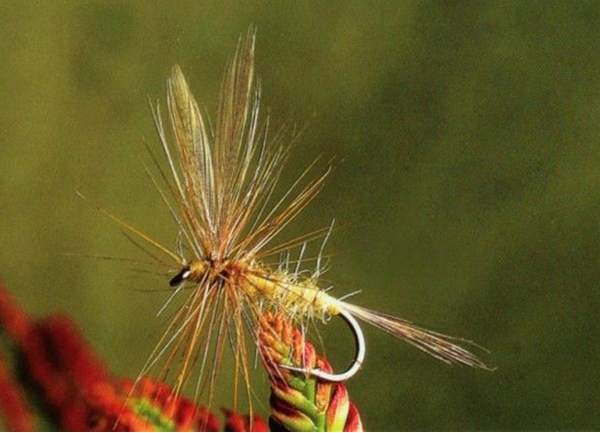
Olive Upright, devised by Guy Mawle
If you are limited to shop-bought flies, I suggest a size 12 Greenwell's Glory for the dun stage, while for the spinner fall switch to a Tups Indispensable of the same size. They work reasonably well in fast water, but in more gentle glides a closer match is likely to give better results, especially on hard-fished river beats.
Excited by rivers and streams? So are we, and we're pretty sure you would find the Winding River Mystery trilogy of action-packed thrillers gripping reading too. Dead Drift, Dead Cert, and Dead End are Pat O'Reilly's latest river-based novels, and now they are available in ebook format. Full details on our website here...
Buy each volume in ebook format for only £2.47 on Amazon... Paperbacks also available on Amazon at £6.95 each. All proceeds go towards keeping the First Nature website online.
Please Help Us: If you have found this information interesting and useful, please consider helping to keep First Nature online by making a small donation towards the web hosting and internet costs.
Any donations over and above the essential running costs will help support the conservation work of Plantlife, the Rivers Trust and charitable botanic gardens - as do author royalties and publisher proceeds from books by Pat and Sue.
